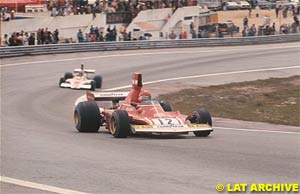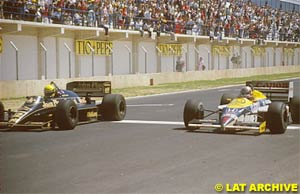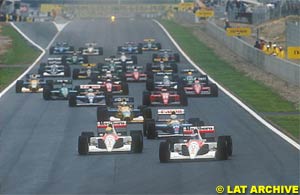
Atlas F1 Contributing Writer
The background of Spain in world-class motor sport dates back to the dawn of the game at the beginning of the 20th century. Journalist and historian Doug Nye looks back at the history of motor racing in Spain and all the venues where the Spanish Grand Prix has taken place in the Mediterranean country
So how long was Spain's background in world-class motor sport? In fact it dates back to the dawn of the game - was not Madrid itself the scheduled destination of the ill-fated Paris-Madrid city-to-city classic of 1903, which closed that particular era after an awful catalogue of disaster and mayhem en route through France? While the racing classes were ordered off the road at Bordeaux, it is too often forgotten that the touring class - which had set out earlier - actually made it all the way to Madrid, and then went off on a holiday tour of the country to round off the adventure.
King Alfonso of Spain was himself an extremely keen motorist, lending his name to a sophisticated lightweight Hispano-Suiza created by Swiss-born engineer Marc Birkigt. In the 1920s the Sitges Autodrome was commissioned just outside Barcelona as an Hispanic rival to Brooklands and Montlhery, and it hosted major International races for a few brief, spectacular years, before falling into disuse…although it has survived largely unspoiled but slumbering to this day, and is currently the subject of restoration plans.
The Spanish Grand Prix title has been given to a list of races beginning as far back as 1913 when a touring car field contested the title at Guadarrama, and Carlos de Salamanca won in - of all things - a Rolls-Royce. In 1923 at Sitges Albert Divo's 2-litre GP Sunbeam won, and at San Sebastian a series of significant road races was contested between 1926-1935 which featured Robert Benoist's Delage, Louis Chiron's Bugattis (twice) and a Scuderia Ferrari Alfa Romeo, Achille Varzi's Maserati, and the Mercedes-Benz W25 variants of Luigi Fagioli and Rudi Caracciola as their winners.
Meanwhile the wealthy Catalan Peña Rhin businessmen's club had backed a road race of its own, run initially at Villafranca in 1921 and won by Pierre (or Pedro) de Vizcaya's Bugatti. Two further Peña Rhin GPs were run at Villafranca, falling to Kenelm Lee Guinness's Sunbeam and Albert Divo's Talbot, before the event lapsed from 1924.
But major development was afoot: re-enter the Peña Rhin businessmen's club - and those enthusiastic Franco-Spanish motoring brothers - Fernand (or Fernando) and Pierre (or Pedro) de Vizcaya.
Fernand's imagination was fired. He was a persuasive businessman and politician and the wealthy and influential local Peña Rhin members backed the notion. In June 1933 Montjuich became the venue for the inaugural Copa Barcelona (the IV Gran Premi Peña Rhin) - and essentially home to 'The Spanish Grand Prix'.
Races had previously been run between 1921-23 on the Circuito Villafranca del Panades Manjos-Almunia, and they would take place at Montjuich in 1933-36, Alfa Romeo winning three times with drivers Juan Zanelli, Achille Varzi and Il Maestro Nuvolari and Mercedes-Benz taking the fourth victory with Luigi Fagioli - 'The Abruzzi Robber' himself.
With Europe ravaged by the Second World War, neutral Spain was quick to offer a postwar motor race with the Peña Rhin GP resuming in Barcelona, but this time on the Pedralbes boulevard circuit, in 1946. Giorgio Pelassa won in a private Maserati. In 1948 Gigi Villoresi took the businessmen's money - again for Maserati - and in 1950 Alberto Ascari took first place for Ferrari and the shrieking V16-cylinder supercharged BRMs failed their maiden major International test.
World Championship-qualifying status devolved upon the Pedralbes race in 1951. It was the Championship-decider - Ascari and Ferrari chose wrong wheel sizes, ran into crippling tyre troubles, and Juan Manuel Fangio won both race and his first world title, for Alfa Romeo in the immortal Tipo 158/159 Alfetta cars' farewell.
The race was revived again at World Championship level at Pedralbes in 1954 - Mercedes failed and future World Champion Mike Hawthorn scored the middle of his three title-status GP wins for Ferrari. But the Spanish Grand Prix as such then lapsed for 14 long years before being revived in 1968 on the Jarama Autodrome - with a field of just 14 starters, and the first GP to follow double-World Champion Jimmy Clark's fatal accident, a low point in World Championship history. It was won by Graham Hill - Jimmy's Lotus teammate, putting the motor racing world back on its feet and proving that life must go on…
In 1969 Montjuich Park was revived in Barcelona, Jackie Stewart all the way in the Tyrrell-entered Matra-Cosworth. 1970 back to Jarama - Stewart victorious in the unlikely looking Tyrrell March 701. In '71 it was back to Montjuich - Jackie's hat-trick, this time driving the definitive Tyrrell-Cosworth. 1972 was Emmo's year - Fittipaldi victorious in the black-and-gold fag packet Lotus 72. The Brazilian made it two in a row in 1973 at Jarama, again Lotus 72-mounted, and the race remained at the Madrid course for '74, when Niki Lauda notched a maiden victory for newly re-emergent Ferrari.
Jarama survived until 1981, but the Spanish Grand Prix was then removed from the World Championship calendar until 1986 when it was revived at the brand-new Jerez de la Frontera circuit way down south, towards Gibraltar.
It was in 1991 that the race finally arrived at its current home - the Circuit de Catalunya at Montmelo on the northern fringes of Barcelona. As described by my friend Alan Henry: "It had originally been intended that the new circuit would not be ready until 1992 - the year in which Barcelona would host the Olympic Games - but political forces had been at work, with the result that the promoters had been persuaded to have the new race track ready for Grand Prix competition a full 12 months ahead of schedule.
"This seemed a tall order when the Formula One teams arrived for the first race in late October 1991. Sure enough, the 3.641-mile (5.859-km) circuit was indeed completed, but the paddock and surrounding areas more closely resembled a building site than a venue for a round of the sport's most prestigious international championship. Yet the drivers' verdict was instantly favourable. As new circuits go, it was impressive and highly enjoyable to drive. It offered plenty of variation, with undulations and fast corners combined with that vital ingredient for overtaking - a sweeping downhill curve leading on to a long main straight, which had a tight corner at the end of it. This is where much of the passing has always taken place."
In 1992, Mansell repeated his Spanish success in pouring rain, en route to his World Championship title for Williams, while in '93 Montmelo witnessed an internecine Williams duel between Alain Prost and Damon Hill. In 1994 Damon Hill followed in his late father's footsteps with Spanish GP victory, in his case for Williams - and in 1995 the circuit was modified - rendering the approach to the Caixa left-hander significantly more challenging but another welcome overtaking opportunity.
In 1996 torrential rain provided the ideal stage for victory by Michael Schumacher - his first for Ferrari - and in 1997 it was Jacques Villeneuve's turn to win for Williams... and so to recent times.
The Spanish Grand Prix has a chequered history amongst motor racing's premier league and gold riband events, but the Montmelo course is well regarded - it is an extremely popular and much-used testing facility for the Formula One circus - and by modern standards encourages real racing. Let's hope we see that this weekend.
This is own-up time. Back in 1967 I spent a night in a seedy Madrid hotel, sleeping neck-deep in a bath of tepid water. It was the only way I could find some relief from an oppressively hot and humid night in what felt like an hermetically sealed hotel room. While it was comfy to start with, I woke up frozen to the core and shivering uncontrollably. Not a good start to reporting the inaugural race meeting at the Spanish capital's brand-new Jarama Autodrome, but that's why I was there.
 It was just a Formula Two race then, although this '60s equivalent of modern Formula 3000 was infinitely superior to the modern stepping-stone category just below Formula One, for it saw all the day's star Formula One drivers mixing it with aspiring young hopefuls in a gloriously competitive free for all - providing a far better measure of relative talent. But Jarama marked Spain's major-league return to the forefront of modern motor racing, after too many years in the doldrums.
It was just a Formula Two race then, although this '60s equivalent of modern Formula 3000 was infinitely superior to the modern stepping-stone category just below Formula One, for it saw all the day's star Formula One drivers mixing it with aspiring young hopefuls in a gloriously competitive free for all - providing a far better measure of relative talent. But Jarama marked Spain's major-league return to the forefront of modern motor racing, after too many years in the doldrums.
 Their father was a banker and amateur sporting driver. His sons built respectable reputations for themselves racing in the 1920s, and particularly as backers - and bankers - to Ettore Bugatti and the Bugatti marque. Fernand de Vizcaya became Bugatti's concessionaire in Catalunya and is considered to have been the man who promoted an idea first put to him by German Mercedes-Benz star driver Rudi Caracciola in 1931. Having just run in the nearby Rabassada hill-climb, they were touring Montjuich Park in Barcelona, viewing all that survived of the 1929 World's Fair there, when the German suggested that its parkland roads could provide a fine Grand Prix circuit.
Their father was a banker and amateur sporting driver. His sons built respectable reputations for themselves racing in the 1920s, and particularly as backers - and bankers - to Ettore Bugatti and the Bugatti marque. Fernand de Vizcaya became Bugatti's concessionaire in Catalunya and is considered to have been the man who promoted an idea first put to him by German Mercedes-Benz star driver Rudi Caracciola in 1931. Having just run in the nearby Rabassada hill-climb, they were touring Montjuich Park in Barcelona, viewing all that survived of the 1929 World's Fair there, when the German suggested that its parkland roads could provide a fine Grand Prix circuit.
 The Spanish authorities returned the Grand Prix at Montjuich for 1975, an event riven by controversy, drama and tragedy. Poorly installed crash barriers led to a driver strike during practice, and in the race Rolf Stommelen's leading Hill-Cosworth suffered the failure of a pioneering carbon-composite component, a wing pillar - which happened to be an ill-chosen duty for this pioneering ultra-light/ultra-rigid material. The car planed crazily over the barriers into a knot of officials, killing four. Jochen Mass was declared winner of the abandoned race, securing ignominious half points for himself and his team, McLaren. And Montjuich was finished for Formula One...
The Spanish authorities returned the Grand Prix at Montjuich for 1975, an event riven by controversy, drama and tragedy. Poorly installed crash barriers led to a driver strike during practice, and in the race Rolf Stommelen's leading Hill-Cosworth suffered the failure of a pioneering carbon-composite component, a wing pillar - which happened to be an ill-chosen duty for this pioneering ultra-light/ultra-rigid material. The car planed crazily over the barriers into a knot of officials, killing four. Jochen Mass was declared winner of the abandoned race, securing ignominious half points for himself and his team, McLaren. And Montjuich was finished for Formula One...
 That inaugural first Spanish Grand Prix at Montmelo provided one of Nigel Mansell's most spectacular performances, as he arrived 24 points behind his deadly rival Ayrton Senna in the World title chase, but vowing to keep fighting right to the very end. He won this race brilliantly, providing one of the most enduring of all modern Formula One TV images as he sat it out with the dangerous Senna - hub to hub at over 170mph (275kmph) into the first chicane. It was a defining moment in modern motor sporting history, and one which has since been emulated many times on this very challenging and fulfilling modern Autodrome.
That inaugural first Spanish Grand Prix at Montmelo provided one of Nigel Mansell's most spectacular performances, as he arrived 24 points behind his deadly rival Ayrton Senna in the World title chase, but vowing to keep fighting right to the very end. He won this race brilliantly, providing one of the most enduring of all modern Formula One TV images as he sat it out with the dangerous Senna - hub to hub at over 170mph (275kmph) into the first chicane. It was a defining moment in modern motor sporting history, and one which has since been emulated many times on this very challenging and fulfilling modern Autodrome.
Please Contact Us for permission to republish this or any other material from Atlas F1.
|
Volume 8, Issue 17
Atlas F1 Exclusive
Interview with Takuma Sato
Jo Ramirez: a Racing Man
Articles
Fisichella's Recurring Nightmare
Spanish GP Preview
Spanish GP Preview
Local History: Spanish GP
Facts, Stats & Memoirs
Columns
The Spanish GP Quiz
Bookworm Critique
Elsewhere in Racing
The Grapevine
> Homepage |